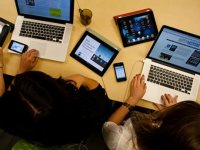The Balance of Screen Time
Your content has been saved!
Go to My Saved Content."Television rots your brain." In a similar vein, video games turn your mind to mush, and staring at a screen for too long potentially makes you a zombie. In 1999, the American Academy of Pediatrics (AAP) published a report suggesting that children under two should not have any screen time. Since the release of that report, numerous studies have emerged to address this issue of screen time, from the 2012 report Facing the Screen Dilemma: Young Children, Technology and Early Education to Lisa Guernsey's Screen Time: How Electronic Media - From Baby Videos to Educational Software - Affects Your Young Child.
Particularly when working with elementary teachers, I frequently hear concerns about screen time in the classroom, and they are not wrong. Students should learn to interact in a face-to-face setting, experience the physical world and go outside. However, much like we cannot say that all television rots our brains, we need to look beyond saying that all screen time is bad for our students. To do that, I like to ask three questions:
- Is it appropriate?
- Is it meaningful?
- Is it empowering?
Appropriate Use
When contemplating screen time, I always come back to this iconic Grover sketch from Sesame Street.
In a preschool setting, would showing this clip, rather than experiencing the concept of near and far in person, be appropriate? Given the need for students to experience the physical world in order to make sense of what is around them, projecting a YouTube video as the sole means for teaching the concept is probably not the most appropriate use of a screen.
However, what if students explored in the physical world, watched Grover, and then created their own videos to demonstrate their understanding of these abstract concepts? What if they published these videos to a class website or blog to interact with a broader audience and extend the learning context beyond the classroom? While a screen may be involved in this activity, it would be enhancing the physical experience rather than replacing it.
Meaningful Interactions
A workshop participant once said that she knew her iPad program had to change when she saw "iPad Time" included on the daily schedule. Though her teachers had found educational apps to reinforce math and reading concepts, the students passively interacted with content rather than constructing understanding. The interaction primarily consisted of students just tapping on a screen.
Lisa Guernsey, in "The Smart Way to Use iPads in the Classroom," described a very different scenario after visiting a school that had deployed over 600 iPads to elementary students:
Consider the image below created by a second grader at Trinity School in Atlanta. While a similar activity could have been undertaken with pen and paper, by incorporating a screen, the student not only had the opportunity to articulate his thoughts, but also to connected with a global audience when the teacher published his creation to her class Twitter account.

Empowered Learners
As a middle school advisor, I frequently found myself in parent conferences discussing the need for their child to "participate more in class." These were bright, well-prepared students who had wonderful insights but not the inclination to speak over the din of their peers.
In Voices for Introverts: A 1:1 Success, Shawn McCusker describes how he found a way to empower all of his students through their screens:
Recently, when teaching this strategy of incorporating backchannels, a participant raised an interesting question: "What happens when a student has to speak up without the aid of a screen?" With technology, are we enabling or empowering? Ben Schersten (@benschersten), instructional technology specialist in Burlington, MA, responded:
Technology doesn't empower only the introverts. Incorporating a device provides all students with an opportunity to make deeper connections with the content as well as their learning. Kristen Wideen empowers her students to connect, question and infer as she reads to them. Through an appropriate and meaningful use of technology, she provides her students with a vehicle to think, collaborate and construct their own meaning, turning a teacher-directed activity into a student-empowered one by incorporating a TodaysMeet backchannel.

Finding the Balance
Regardless of the amazing affordances of technology, we do have to be mindful of when it’s a good thing to unplug. Taking time away from the constant glare of a screen, as well as the pressure of always-on connectivity, can reduce stress, relieve eyestrain and support a healthier lifestyle. Perhaps, even more important, is the need to balance screen time with the learning experiences that students gain from the peers and adults around them. With the growing numbers of screens being introduced into classrooms, the challenge for teachers is to maintain a balance between the physical and virtual worlds as well as to ensure that screens are being used in appropriate, meaningful and empowering ways.
